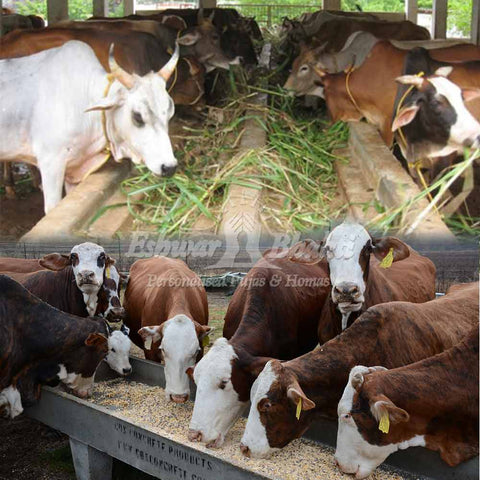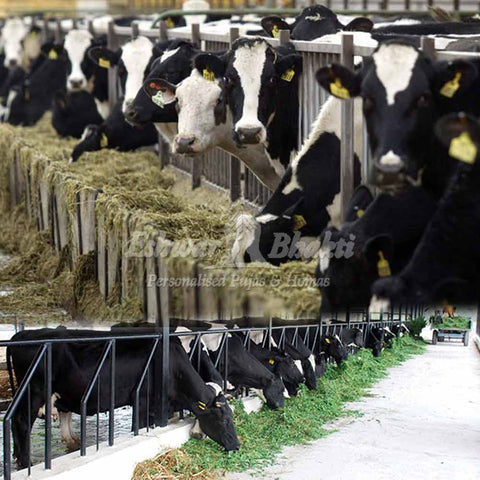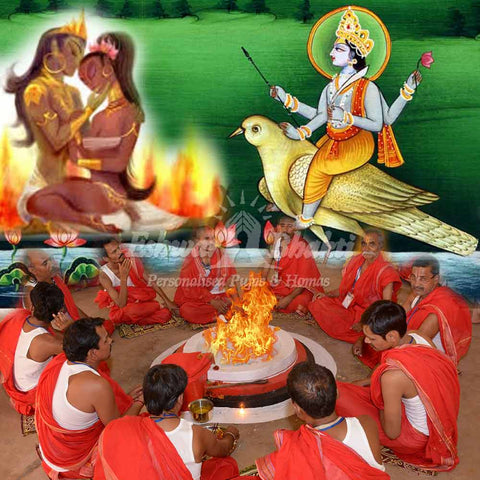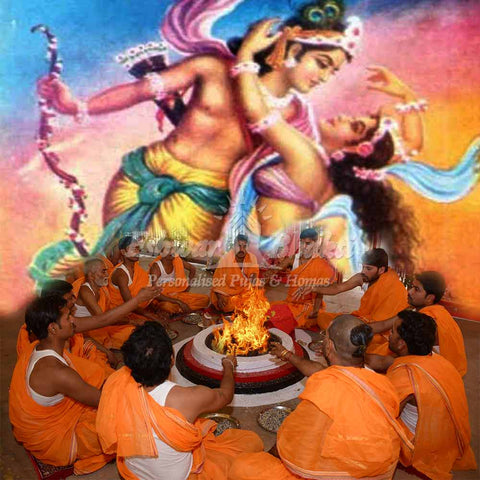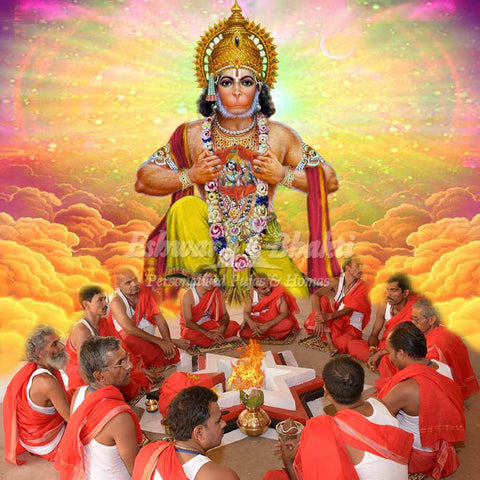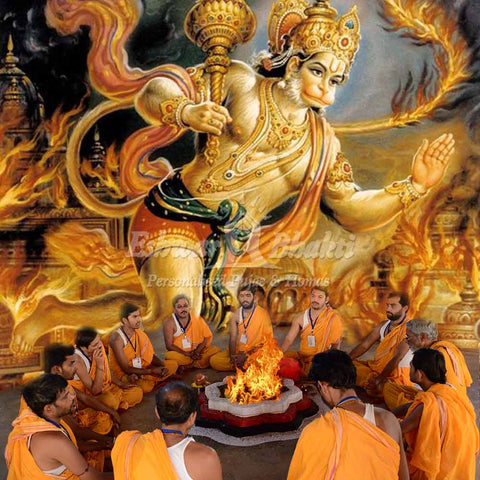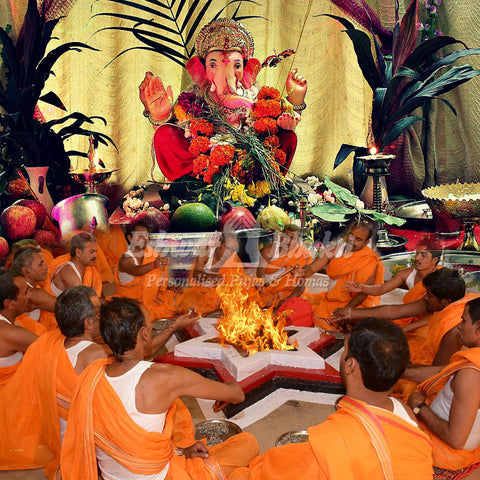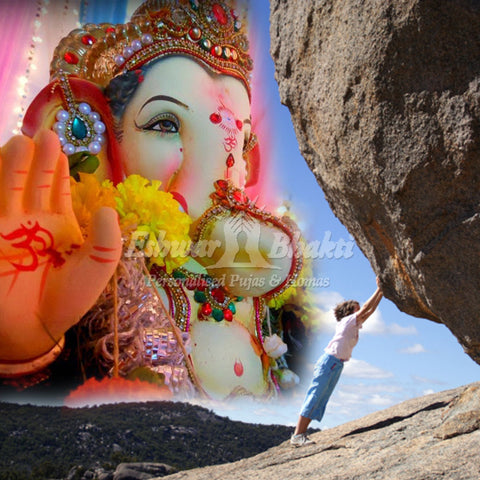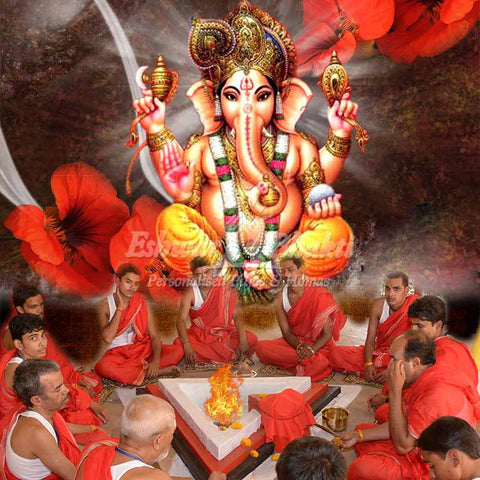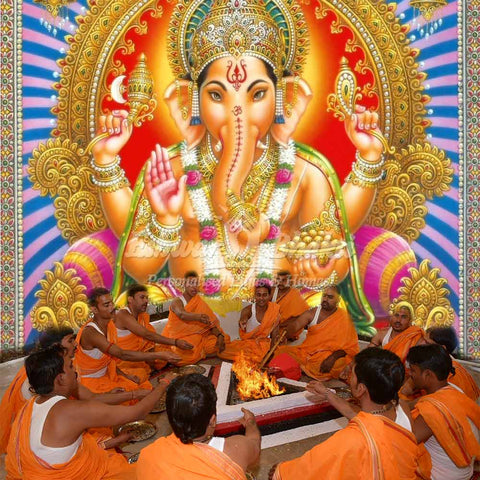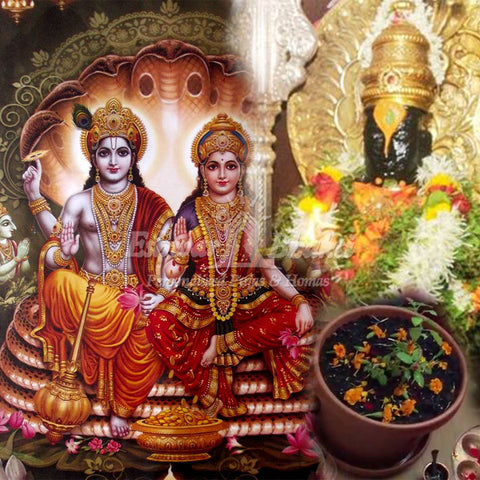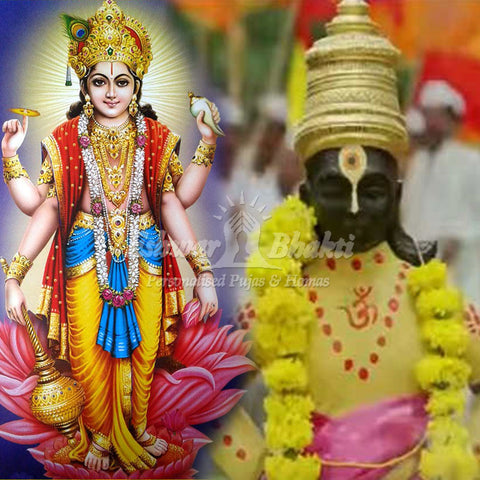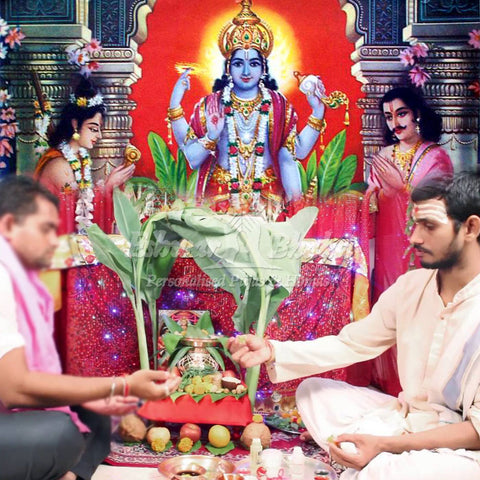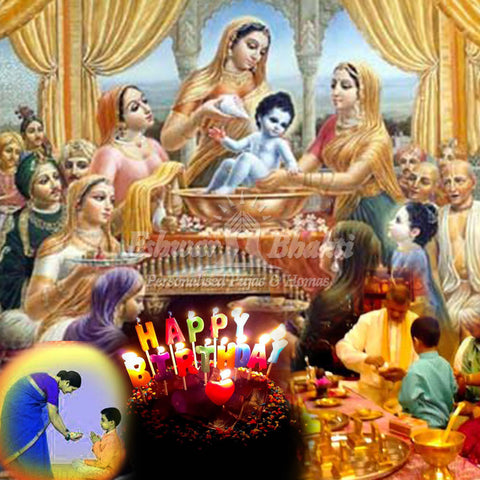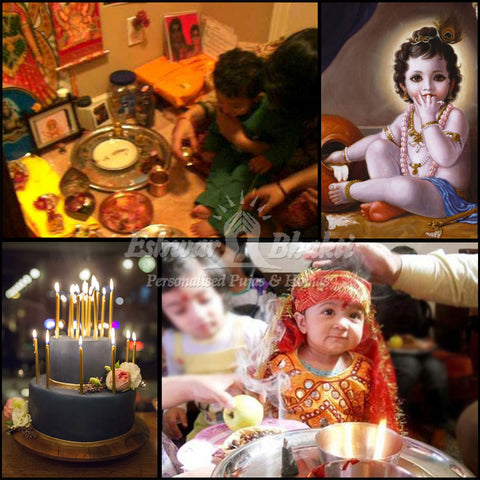Dashavtaar Puja & Yagna
Prayers to all the ten incarnations of Lord Vishnu
The first four incarnations of Vishnu appeared in Satya or Krita Yuga, the first of the four Yugas, also called 'The Golden Age'. The next three appeared in Treta Yuga, the eighth and ninth in Dwapara Yuga and the tenth will appear in Kali Yuga.
The ten incarnations of Lord Vishnu are:
1. Matsya, the fish, from the Satya Yuga. Lord Vishnu takes the form of a fish to save Manu from a flood, after which he takes his boat to the new world along with one of every species of plant and animal, gathered in a massive cyclone.
2. Kurma, the tortoise, appeared in the Satya Yuga. When the devas and asuras were churning the Ocean of milk in order to get amrita, the nectar of immortality, the mount Mandara they were using as the churning staff started to sink and Lord Vishnu took the form of a tortoise to bear the weight of the mountain.
3. Varaha, the boar, from the Satya Yuga. He appeared to defeat Hiranyaksha, a demon who had taken the Earth, or Prithvi, and carried it to the bottom of what is described as the cosmic ocean in the story. The battle between Varaha and Hiranyaksha is believed to have lasted for a thousand years, which the former finally won. Varaha carried the Earth out of the ocean between his tusks and restored it to its place in the universe.
4. Narasimha, the half-man/half-lion appeared in the Satya Yuga. The rakshasa Hiranyakashipu, the elder brother of Hiranyaksha, was granted a powerful boon from Brahma, not allowing him to be killed by man or animal, inside or out, day or night, on earth or the stars, with a weapon either living or inanimate. Vishnu descended as an anthropomorphic incarnation, with the body of a man and head and claws of a lion. He then disembowels the rakshasa at the courtyard threshold of his house, at dusk, with his claws, while he lay on his thighs.
5. Vamana, the dwarf, appeared in the Treta Yuga. The fourth descendant of Hiranyakashyap, Bali, with devotion and penance was able to defeat Indra, the god of firmament. This humbled the other deities and extended his authority over the three worlds. The gods appealed to Vishnu for protection and he descended as the dwarf Vamana. During a yajna of the king, Vamana approached him in the midst of other Brahmins. Bali was happy to see the diminutive holy man, and promised whatever he asked. Vamana asked for three paces of land. Bali agreed, and the dwarf then changed his size to that of a giant. He stepped over heaven in his first stride, and the netherworld with the second. Bali realized that Vamana was Vishnu incarnate. In deference, the king offered his head as the third place for Vamana to place his foot. The avatar did so and thus granted Bali immortality. Then in appreciation to Bali and his grandfather Prahlada, Vamana made him ruler of Pathala, the netherworld. Bali is believed to have ruled Kerala and Tulunadu. He is still worshiped there as the king of prosperity and recalled before the time of harvest.
6. Parashurama, Rama with the axe, appeared in the Treta Yuga. He is son of Jamadagni and Renuka. He received an axe after a penance to Shiva. Parashurama is the first Brahmin-Kshatriya in Hinduism, or warrior-saint, with duties between a Brahmana and a Kshatriya). His mother was from the Kshatriya Suryavanshi clan that ruled Ayodhya, of the line of Rama. King Kartavirya Arjuna and his army visited the father of Parashurama at his ashram, and the saint was able to feed them with the divine cow Kamadhenu. The king demanded the animal, Jamadagni refused, and the king took it by force and destroyed the ashram. Parashurama then killed the king at his palace and destroyed his army. In revenge, the sons of Kartavirya killed Jamadagni. Parashurama took a vow to kill every Kshatriya on earth twenty-one times over, and filled five lakes with their blood. Ultimately, his grandfather, the great rishi Rucheeka, appeared and made him halt. He is a Chiranjivi, and believed to be alive today in penance at Mahendragiri.
7. Shree Rama, Ramachandra, the prince and king of Ayodhya, appeared in the Treta Yuga. Rama is a commonly worshiped avatar in Hinduism, and is thought of as the ideal heroic man. His story is recounted in one of the most widely read scriptures of Hinduism, the Ramayana. While in exile from his own kingdom with his brother Lakshman and the monkey king Hanuman, his wife Sita was abducted by the demon king of Lanka, Ravana. He travelled to Ashoka Vatika in Lanka, killed the demon king and saved Sita.
8. Balarama , also known as Baladeva, Balabhadra and Halayudha, is the elder brother of Krishna, he is considered as the Sankarshana form of Vishnu and the eighth avatar of Vishnu. In Vaishnavism, a major branch of Hinduism, Balarama is worshipped as an avatar of Adishesha, and he is described as such in the Bhagavata Purana. As brother of Krishna, he is worshipped either with his sibling as the eighth avatar of Vishnu. He may have originated in Vedic times as a deity of agriculture and fertility. In scripture, Vishnu impregnated the belly of the goddess Devaki with two hairs, one black, one white. To ensure their safety, they were transferred before birth to Rohini. Krishna was born with darker complexion, while Balarama was fair. In Jainism he is known as Baladeva. He is often depicted with a drinking cup, pitcher, shield and sword.
9. Krishna, was the eighth son of Devaki and Vasudev. Krishna is the most commonly worshiped deity in Hinduism and an avatar inVaishnava belief. His name means 'dark' or 'attractive', and he appeared in the Dwapara Yuga alongside his brother Balarama (generally included as one of Dashavatara in Sri Vishnava lists, instead of Buddha), and was the central character of the Bhagavad Gita, the most published Hindu canon. He is mentor to Arjuna, delivering him the Gita at the Battle of Kurukshetra. He is often depicted playing the murali and having a mischievous spirit. The appearance of Krishna coincided with the beginning of Kali Yuga.
10. Kalki, is the final incarnation of Vishnu, foretold to appear at the end of Kali Yuga, our present epoch. He will be atop a white horse and his sword will be drawn, blazing like a comet. He is the harbinger of end time in Hindu eschatology, and will destroy all unrighteousness and evil at the end of Kali Yuga.
This puja can be done:
-
With Stotra recitations: Puja service includes: Sthapana (Ganesh, Devi, Navgraha Kalash, Brahma), Swasti Vachan, Sankalp, Ganesh Pujan, Navgraha Puja, Invocation of major Gods, Brahman Varn, Dasavtaar Pujan, 11000 chants of Dasavtaar Stotra, Dasang Havan, Donation & food to brahmins.
Number of priests: 11 ; Duration: 7 days -
Mantra Jaap & Yagna: Puja service includes: Sthapana (Ganesh, Devi, Navgraha Kalash, Brahma), Swasti Vachan, Sankalp, Ganesh Pujan, Navgraha Puja, Invocation of major Gods, Brahman Varn, Dasavtaar Pujan, total 125000 Gayatri mantra jaap of the incarnations, Dasang Havan, Donation & food to brahmins.
Number of priests: 11 ; Duration: 11 days.
Make your selection of Puja type from the box above.
Eshwar Bhakti priests will perform your Puja as per the Vedic procedure. Please mention your birth details (name, date, time, and place of birth), & Sankalp (your wish) at checkout. This is an individual Puja (you may book puja only on your name or include your near/dear ones in your puja).
You can book this puja with or without a DVD. An hour-long DVD will have the main elements of your puja: Sankalpa, Abhishek or invocation mantras, presiding deity mantra chants, Homa and Aarti. If you opt for a DVD, we will upload it on a cloud link for you to download and watch online, within a week of your puja completion. If you don't opt for a DVD, we will email few short video clips and photos immediately upon successful completion of your ritual.
Performing your puja ritual with love and utmost care is our motto. We perform only Individual Personalized rituals. No group rituals. Here are the key steps to help you understand the process:
 You add a ritual to your shopping cart, after reading the benefits and based on your concerns.
You add a ritual to your shopping cart, after reading the benefits and based on your concerns.
 At the time of booking your ritual(s), you are asked to provide your "Name, birth details, Sankalpa and instructions" on the shopping cart page. You can also mention your Gotra, Nakshatra and Rashi details there (if you know).
At the time of booking your ritual(s), you are asked to provide your "Name, birth details, Sankalpa and instructions" on the shopping cart page. You can also mention your Gotra, Nakshatra and Rashi details there (if you know).
 Immediately after the receipt of your order, we start identifying the most auspicious date and time to perform the ritual.
Immediately after the receipt of your order, we start identifying the most auspicious date and time to perform the ritual.
 An email is sent to you within 12 hours of order confirmation, which would comprise:
An email is sent to you within 12 hours of order confirmation, which would comprise:
1. Date on which your puja would be performed.
2. Complete timings and duration of your ritual.
3. Sankalpa time: When you can join us and pray for the fulfillment of your wish.
4. Zoom meeting details for taking the Sankalpa.
5. Mantra and meditation instructions to follow at your end.
6. Dietary precautions on the day of your puja.
7. List of some easy to get items, to take the Sankalpa.
 You can also email us your photo, at contact@pujayagna.com, to keep during the performance of your puja (optional).
You can also email us your photo, at contact@pujayagna.com, to keep during the performance of your puja (optional).
 On the scheduled day and time, you can join over Zoom to take your Sankalpa (optional). You will be guided during the call to take the Sankalpa.
On the scheduled day and time, you can join over Zoom to take your Sankalpa (optional). You will be guided during the call to take the Sankalpa.
 Immediately after the successful completion of your ritual, an email is sent with photos/videos of the ritual.
Immediately after the successful completion of your ritual, an email is sent with photos/videos of the ritual.
 In case of rituals lasting over several days, you will receive daily updates over email, WhatsApp or Viber.
In case of rituals lasting over several days, you will receive daily updates over email, WhatsApp or Viber.
Have more queries, read Frequently Asked Questions.




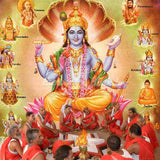
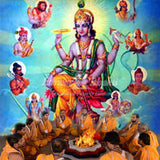

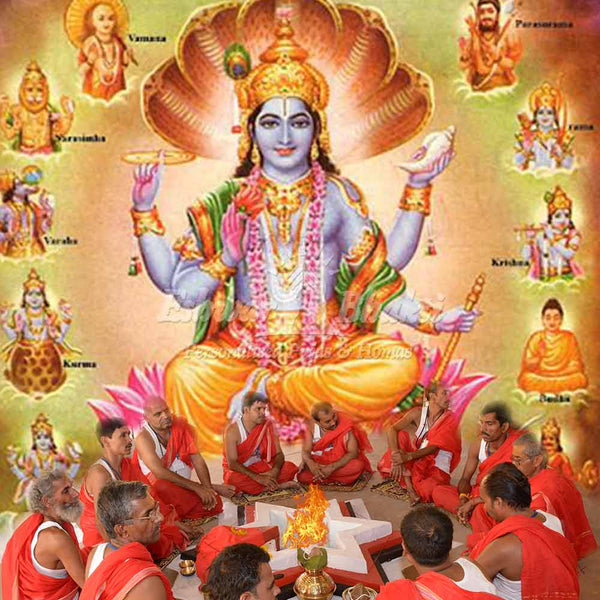





 Related Pujas
Related Pujas 
